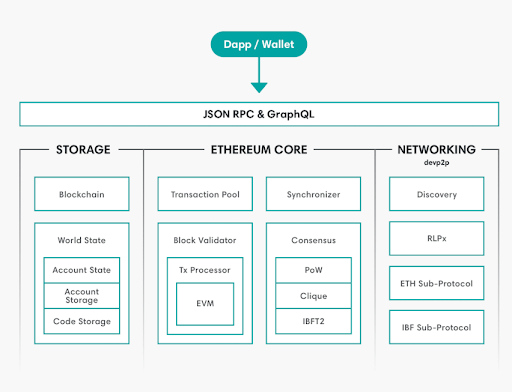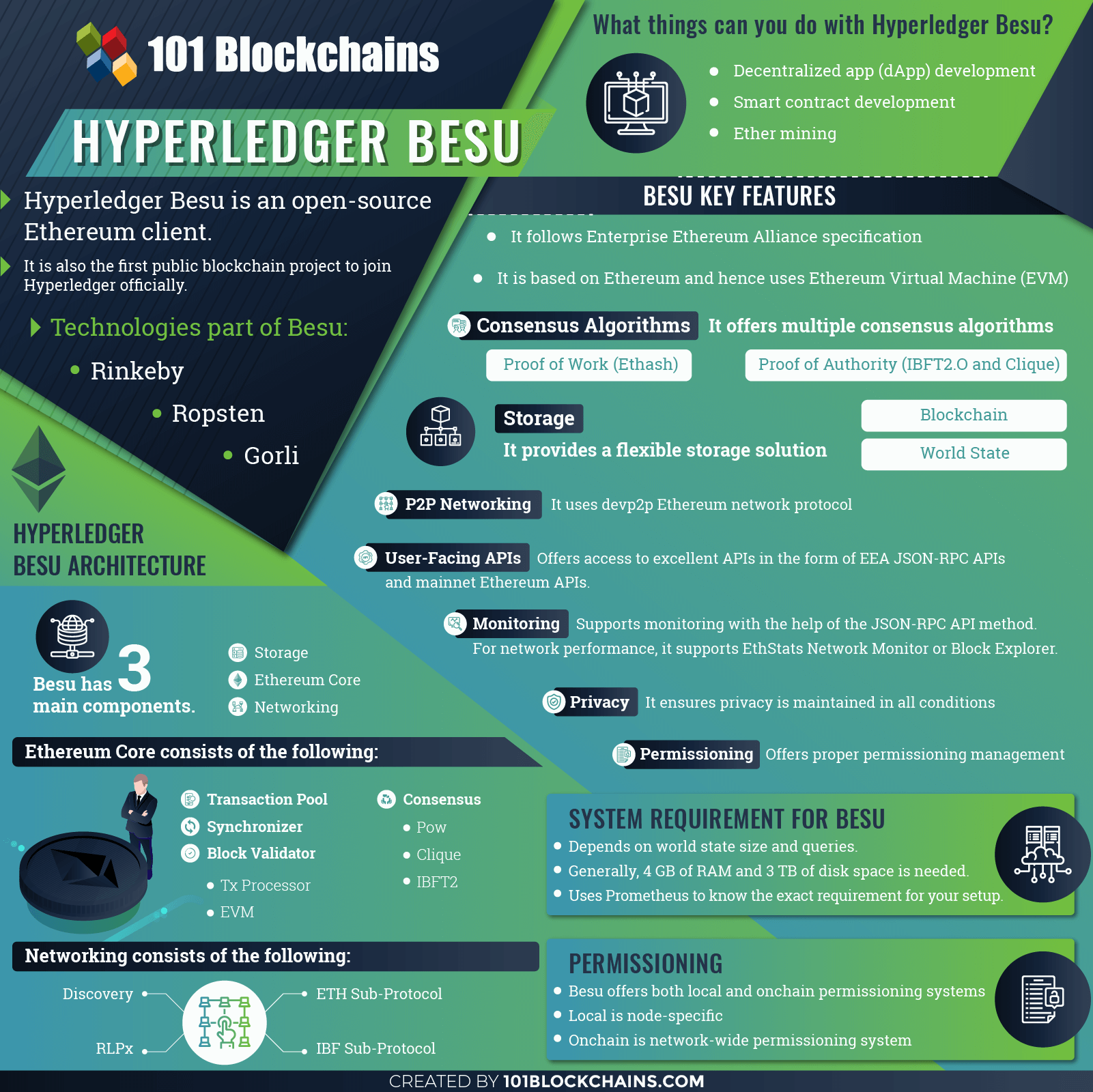Learn how blockchain truly works, master key definitions, and uncover what makes smart contracts so "smart." Dive into the fundamentals, gain valuable insights, and start your blockchain journey today!

- Analyst Corner
Gwyneth Iredale
- on September 26, 2020
Introduction to Hyperledger Besu
The landscape of Blockchain Technology is continuously expanding with the addition of new and striking projects. Among the many prominent mentions in the world of Blockchain, Hyperledger has recently established a promising platform for promoting distributed ledger technology projects. One of the notable projects in the Hyperledger domain, Hyperledger Fabric, has been a critical booster in Blockchain solution development while another one is the Hyperledger Besu.
Executive Summary
The primary focus of this discussion paper is the Hyperledger Besu, the latest addition among the Hyperledger projects.
- It provides a reliable platform for building public network use cases by leveraging the Ethereum public network. It also allows the creation of permissioned networks.
- It operates according to the Enterprise Ethereum Alliance standard, a standard reference for the creation of common interfaces between different closed and open source projects in the Ethereum ecosystem.
- It facilitates the adoption of different consensus mechanisms.
- Peer-to-peer networking represents one of the prominent features of Hyperledger Besu.
- Monitoring the performance of nodes and networks is another important element of Hyperledger Besu.
- Privacy ensures that external parties cannot access the list of parties involved in the transaction, or the transaction content, or reference of the sending and receiving parties.
One of the most wide-ranging applications associated with Hyperledger Besu is in the pharmaceutical industry. In the Save Pharmaceutical project, unused medicines are returned and provided to patients who need them through a platform based on Hyperledger Besu that connects drug repositories (e.g., pharmacies), drug donors (e.g., clinics), individual patients, and assisted living facilities and patients. The platform ensures a permissioned enterprise-level network to operate as a drug repository system.
Let us discover the definition of Hyperledger Besu alongside its architecture and features. Most important of all, the following discussion would emphasize on the functionalities and its notable use cases.
Excited to learn the basic and advanced concepts of Hyperledger Fabric? Enroll Now in Getting Started with Hyperledger Fabric Course
Definition of Hyperledger Besu
Hyperledger Besu is basically an open-source Ethereum client based on Java and is the initial Blockchain project on Hyperledger that supports operations across public Blockchains. Now, enterprises are more driven towards the Hyperledger ecosystem due to Besu, which provides a reliable platform for building public network use cases according to their application requirements.
Therefore, enterprises don’t have to worry about restrictions to permissioned Blockchain use cases only with Hyperledger Besu. It leverages the Ethereum public network for operations. The specific goal of the architecture and design focuses on modularity and clean interfaces. It is specifically tailored as an ideal platform to enable open-source development and deployment.

The modularity in the design is evident in the isolation of concerns among consensus algorithms and various critical Blockchain features. As a result, the modular approach supports easier implementation and upgrades for all its components. The creation of clean interfaces among the different elements in the client infrastructure with offers an easier configuration of Ethereum for addressing their needs.
In addition, it also addresses the business needs while providing flexibility for the integration of different Hyperledger projects and specific use elements in the codebase. Written in Java and developed under Apache 2.0 license, It can run on Ethereum’s public network as well as networks with private permissioning and test networks like Gorli, Rinkeby, and Ropsten.
Build your identity as a certified blockchain expert with 101 Blockchains’ Blockchain Certifications designed to provide enhanced career prospects.
Importance of Ethereum Client
Now, it is important to reflect on the most prominent aspect in the definition of Hyperledger Besu. Ethereum client, remember? So, what is an Ethereum client? It is basically the software responsible for the implementation of the Ethereum protocol for a specific use case. Ethereum clients have application programming interfaces (APIs) that enable application developers to interact with the Blockchain.
Ethereum clients have the execution environment tailored for processing Ethereum Blockchain transactions. They also facilitate Peer-to-Peer (P2P) networking to ensure communication with different Ethereum nodes across the network for synchronizing state. In addition, users also get storage for persisting data that primarily focuses on executing transactions. These aspects clearly showcase the efficiency of Hyperledger Besu.
Excited to learn the basic and advanced concepts of ethereum technology? Enroll Now in The Complete Ethereum Technology Course
Features of Hyperledger Besu
The next important concern in an introduction to Hyperledger Besu primarily refers to its features. It presently operates according to the Enterprise Ethereum Alliance (EEA) standard. EEA specification is a standard benchmark for the creation of common interfaces between different closed and open source projects in the Ethereum landscape.
As a result, users don’t have to face vendor lock-in while also gaining adequate functionality of standard interfaces across teams for application development. It ensures the implementation of enterprise features with respect to the specification of EEA clients. Now, let us take a look at an outline of the other features you can avail of Hyperledger Besu.
-
EVM
Ethereum Virtual Machine in the Hyperledger Besu is a Turing complete virtual machine, which supports deploying and executing smart contracts through transactions in Ethereum Blockchain.
-
Consensus Mechanisms
Hyperledger Besu facilitates different consensus mechanisms in the form of two distinct algorithms. The consensus algorithms help in the implementation of different consensus algorithms related to block production, block validation&transaction validation. The two prominent consensus algorithms are Proof of Authority and Proof of Work. The Proof of Authority protocols is ideal in cases where the participants in transactions know each other. The Proof of Work (or Ethash) is suitable for use cases that focus on mining activities related to the mainnet Ethereum.
Curious to learn about blockchain implementation and strategy for managing your blockchain projects? Enroll Now in Blockchain Technology – Implementation And Strategy Course!
-
Storage Features
The next important feature of Hyperledger Besu refers to the storage. It provides the RocksDB key-value database for persisting chain data on a local node level. The data is classified into certain sub-categories, such as Blockchain data and World State data.
The Blockchain data includes block headers constituting the data chain, which helps in cryptographic verification of the Blockchain state. Each block header points to a World State through the stateRoot hash, and World State data indicates the mapping to accounts from different addresses. External-ownership accounts have ether balance, and smart-contract based accounts could also contain executable storage and code.
-
P2P Networking
One of the prominent terms that come along with Hyperledger Besu is P2P networking. Hyperledger Besu leverages the devp2p network protocols of Ethereum for enabling communication between clients. In addition, it also provides a sub-protocol tailored specifically for IBFT2.
-
User-facing APIs
Another notable feature of Hyperledger Besu refers to the user-facing APIs in the form of EEA JSON-RPC APIs and mainnet Ethereum APIs. The APIs support WebSocket and HTTP protocols. Furthermore, Hyperledger Besu also offers the GraphQL API.
-
Monitoring
Monitoring is one of the foremost strengths in the features of Hyperledger Besu as it enables operations on Ethereum public network. It includes functionalities of monitoring the performance of nodes and networks. Hyperledger Besu utilizes the debug_metrics JSON-RPC API method or Prometheus for monitoring node performance. On the other hand, Alethio tools likeEthStats Network Monitor and Block Explorer help in monitoring network performance.
-
Privacy
Among the many factors that stand out in the feature list of Hyperledger Besu, privacy has a prominent place. Privacy primarily refers to maintaining the privacy of transactions between the only parties involved in the transaction.
It ensures that external parties could not access the list of parties involved in the transaction, transaction content, or the sending and receiving party. The Private Transaction Manager is its formidable strength in safeguarding the privacy of transactions.
Start your blockchain journey Now with the Enterprise Blockchains Fundamentals
-
Permissioning
The final, yet a significant addition in the features of Hyperledger Besu, refer to the support for permissioning. While It supports use cases of a public network, it also allows the creation of permissioned networks. Permissioned networks would involve authentication only for specific nodes &accounts.
Users can enable account permissioning or node permissioning on the network according to their preferences. In addition, users also get the benefit of local as well as on-chain permissioning with Hyperledger Besu. Local permissioning utilizes configuration file for permissioning at the node level. On the other hand, on-chain permissioning involves the use of smart contracts at the network level.

Functionalities Supported on Hyperledger Besu
The functionalities of Hyperledger Besu are also one of the prominent reasons for driving its popularity. It provides the CLI (Command-Line Interface) along with WebSocket & HTTP-based APIs to ensure proper running, maintenance, and monitoring of nodes on the Ethereum network. Client APIs provide adequate support for general Ethereum functionalities, including smart contracts, dapp development, use cases involving operations, and deployment.
The tools like web3j, Truffle, and Remix help in supporting these activities. Furthermore, the Hyperledger Besu client also ensures support for the implementation of common JSON-RPC APIs. Therefore, users don’t have to face difficulties with integration and ecosystem tooling. The Hyperledger Besu client also provides support for the creation of private consortium networks with permissions.
Hyperledger Besu currently doesn’t have support for key management with the client owing to security issues. On the other hand, users can leverage the EthSigner or other Ethereum-compatible wallets for the management of private keys. Tools such as EthSigner also facilitate access to the key store alongside signing transactions through tools such as Microsoft Azure and Hashicorp Vault.
As mentioned already, it also supports node & account permissioning on the basis of local configuration and smart contracts. In addition, the zero-knowledge methods associated with the client can also facilitate private transactions in unison with the Aztex protocol. If the case involves an off-chain approach, then you can use Orion, which is an open-source private transaction manager.
Practical Use Case of Hyperledger Besu
The final concern in any introduction to Hyperledger Besu would primarily refer to its practical use cases. One of the most wide-ranging applications associated with it is in the pharmaceutical industry. The problem of pharmaceutical waste in the US is one of the prominent issues with wastage of almost $2 billion worth of prescription drugs annually.
Massive volumes of prescription drugs remain unused in clinics, individual patient homes, and assisted living facilities. Therefore, the most plausible solution, in this case, might point towards destroying unused medication. However, the cost of disposing of unused drugs is another critical setback.
Furthermore, the legal precedents for disposing of unused drugs through incineration could create prominent environmental concerns. So, the most productive solution, in this case, would be a mechanism that can return unused medicines and provide them to patients who need them. Such a solution must comply with the following practical aspects for better efficiency.
- Motivation for pharmacies to serve as facilities to accept unused drugs
- Motivation for patients and clinics to donate unused drugs
- Comprehensive control and transparency over the quality and expiration of donated drugs
- Data security
One of the best examples of the use of Hyperledger Besu in creating such a solution is the Save Pharmaceutical project. The platform leverages Hyperledger Besu for connecting drug repositories, i.e., pharmacies, drug donors such as clinics, individual patients, and assisted living facilities and patients.
The Save Pharmaceutical project is currently under development and would turn out to be an exceptionally multi-functional product. It can be the ideal platform for donors to donate medications they are not using, and pharmacies could easily approve or reject the donated pharmacies. As a result, patients who need drugs and cannot avail of them due to financial difficulties can get the best quality drugs.
Hyperledger Besu serves as the ideal option in this use case because of its facility for operations on a public network. Therefore, patients could access information about the availability of drugs at pharmacies. In addition, the facility of permissioning can help pharmacies maintain better control over the acceptance and verification of quality of drugs.
As a result, Hyperledger Besu can ensure a permissioned enterprise-level network for working as a drug repository system. One can clearly notice that It is ideal for mission-critical applications on private Blockchain while utilizing features of permissionless protocol.
Not sure how to build your career in enterprise blockchains? Enroll Now in How to Build Your Career in Enterprise Blockchains Course
Conclusion
The introduction of Hyperledger Besu in the Hyperledger ecosystem would spell new opportunities for enterprises to avail benefits of public network use cases. Most important of all, It ensures simple and flexible setup and installation through its general system requirements.
It is easier to establish system requirements for Hyperledger Besu with a clear impression of the network specifications such as query complexity, world state size, block gas limit, and the number of transactions. Furthermore, the open community of Hyperledger Besu also drives additional contributions to its ecosystem every day. The adoption of Hyperledger Besu is slowly gaining momentum. Learn more about Hyperledger Besu right now to capitalize on the opportunity!
*Disclaimer: The article should not be taken as, and is not intended to provide any investment advice. Claims made in this article do not constitute investment advice and should not be taken as such. 101 Blockchains shall not be responsible for any loss sustained by any person who relies on this article. Do your own research!






